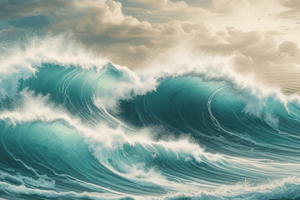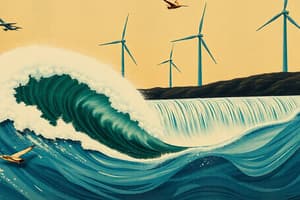Podcast
Questions and Answers
What determines the size and energy of a wave?
What determines the size and energy of a wave?
- Number of breakers
- Fetch and strength of the wind (correct)
- Height of the wave
- Length of the backwash
Which type of wind will produce large powerful waves over a long fetch?
Which type of wind will produce large powerful waves over a long fetch?
- South-easterly (correct)
- North-easterly
- Easterly
- North-westerly
What are the characteristics of destructive waves?
What are the characteristics of destructive waves?
- Low energy
- Gentle breakers
- Strong swash and backwash
- Weak swash and backwash (correct)
What is the water that flows back towards the sea known as?
What is the water that flows back towards the sea known as?
What does a tall breaker do?
What does a tall breaker do?
How do constructive waves differ from destructive waves?
How do constructive waves differ from destructive waves?
What are the characteristics of a constructive wave?
What are the characteristics of a constructive wave?
How does freeze-thaw weathering occur in rocks?
How does freeze-thaw weathering occur in rocks?
What is the primary impact of plants on rocks in biological weathering?
What is the primary impact of plants on rocks in biological weathering?
How can rainwater contribute to chemical weathering of rocks?
How can rainwater contribute to chemical weathering of rocks?
What describes mudflow as a type of mass movement?
What describes mudflow as a type of mass movement?
What happens during rotational slip mass movement?
What happens during rotational slip mass movement?
Flashcards are hidden until you start studying
Study Notes
Wave Types
- Wave size and energy depend on fetch, wind strength, and duration
- Long fetch (>8000 km) with south-westerly wind produces large, powerful waves
- Short fetch (<200 km) with south-easterly wind produces small waves
- Constructive waves: high in proportion to length, weak swash, strong backwash
- Destructive waves: low in proportion to height, strong swash, weak backwash
- Destructive waves: steep, close together, remove sediment from beach
- Constructive waves: low, far apart, bring sediments to build up beach
Weathering
- Freeze-thaw weathering: water enters rock cracks, freezes, expands, and widens cracks
- Biological weathering: plant roots burrow, weaken rock structure, and break away
- Chemical weathering: rainwater and seawater (weak acid) dissolve rocks like limestone and chalk
Mass Movement
- Mass movement: downhill movement of sediment due to gravity
- Types of mass movement:
- Rockfall: rocks fall off cliff face, forming scree at the bottom
- Mudflow: saturated soil flows down slope, forming a lobe at the bottom
- Landslide: large blocks of rock slide downhill
- Rotational slip: saturated soil slides down a curved slip plane
Studying That Suits You
Use AI to generate personalized quizzes and flashcards to suit your learning preferences.




